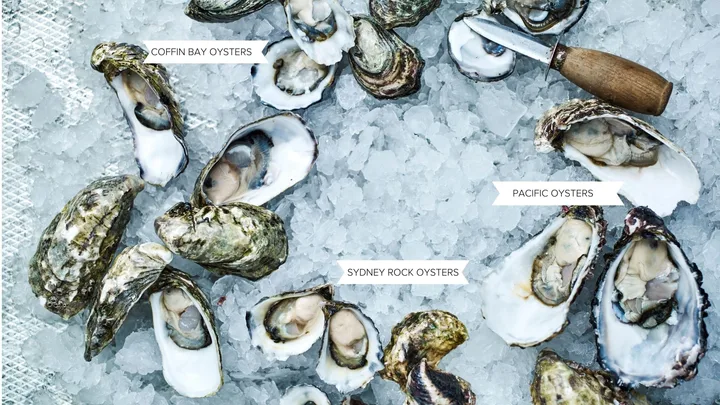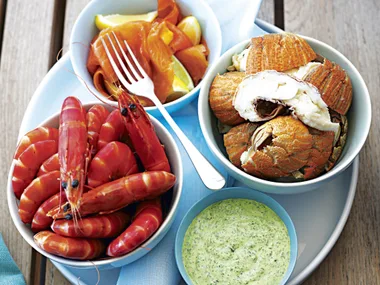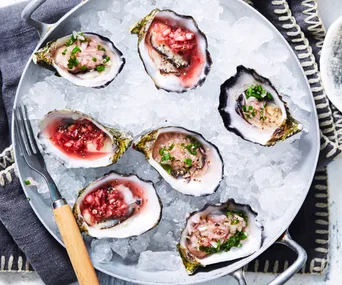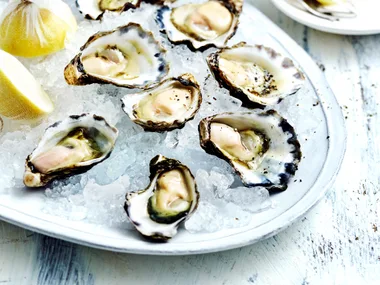Oysters are bivalve molluscs, usually found in colonies and growing in shallow waters. As filter feeders, they’re very sensitive to water quality and can retain toxins in their flesh.
Oysters should only be harvested from the most pristine of marine environments. In many instances, depuration (purging in high-quality water) is mandatory, post-harvest, to clean them out. Although there are hundreds of varieties, there are only a handful of actual species (note that pearl oysters are from a different family of bivalves). True food oysters are from the Ostreidae family and they’ve been cultivated since Roman times. The richness of marine nutrients found in a particular habitat has a huge impact on oyster flavour; therefore, flavours vary among regions.
Buying oysters
Sydney rock oysters
An Australian and New Zealand native, these are also called western rock oysters when they’re sourced from Albany in Western Australia. Shells are deep with a slightly ripped edge. Rock oysters are very hard, hence the name. The bulk of Sydney rock oysters come from farms around the NSW and the lower Queensland coast. They reach a weight of around 50g after three years. Generally, they are at their best eating from September to March. Although some prefer the stronger, saltier flavours they exhibit over winter. Their rich, creamy flesh is best eaten when freshly shucked. Unopened, they have a decent shelf life (up to 2 weeks) if kept under the right conditions.
Coffin Bay oysters
A world-class farmed oyster from Coffin Bay in South Australia, these are, in fact, pacific oysters. They were first grown here in 1969 and since then have become in-demand across Australia and internationally. It’s the nutrient-rich and pristine water here that makes this oyster so special. They’re a good example of how the taste of an oyster species varies from region to region and bay to bay, not unlike wine. As with all oysters, the best way to appreciate their salty, flinty, minerally taste and smooth juiciness is to eat them raw. You can also lightly poach, stir-fry, steam, grill, fry and barbecue them.
Pacific oysters
Introduced to Tasmania from Japan in the 1940s, these are generally slightly larger than the Sydney rock oyster and take less time to grow to marketable size. Their shells are a bit spiky and quite oval in shape – some can be rather elongated. They’re mostly farmed in Tasmania, South Australia and in parts of NSW. They’re banned from growing in Victoria and WA as they are a threat to the native rock oyster (stocks in NSW are sterile). Available year-round, the peak is April through to September when they taste sweet, creamy and briny. They’re best avoided over the warm months of January and February when they are spawning and turn milky and soft.
How to shuck oysters
What you need
An oyster shucking knife is a MUST. Do not attempt to shuck oysters with a kitchen knife, this will not end well! Shucking knives have a sturdy, pointed blade with a rounded tip to minimise the risk of injury and a comfortable handle for a secure grip. They are available from kitchenware shops. To keep your board stabilized, place a damp cloth underneath it. An oyster glove is useful if you will be shucking oysters regularly or a folded tea towel will also work to protect your hand.

The technique
1. Scrub oyster shells under cold, running water to remove any dirt, then use a brush or a rough cloth to clean them thoroughly.
2. Place a damp piece of paper towel or cloth under a chopping board to stabilise it. Place an oyster, flat-side down on the board with the pointy (hinge) end facing away from you. Wrap the other end of the oyster in a folded tea towel and cover your hand with the towel.
3. Holding the oyster down firmly on the board, insert the tip of the oyster knife into the hinge of the oyster, wriggling it gently to release the hinge until it separates. Be careful not to force it, which could damage the delicate oyster inside, though oysters are robust so this will take some effort. If you do happen to pierce the oyster, rest assured it is still edible and you can flip it to disguise the fact.
4. Once the knife is inside, slide it along the top shell, cutting the muscle that holds the oyster closed. Separate the shells and remove the top shell. Keep the oyster level to prevent any of its natural liquid from spilling. Inspect the oyster, it should be plump and translucent with a fresh sea aroma. If you notice an off-putting odour or an oyster that doesn’t look right it’s always best to discard it.
5. For the final step, slide the knife under the oyster to gently loosen it from the shell and flip the oyster over.

How to serve oysters raw
Place them on the half shell on a bed of crushed ice, with a little freshly ground black pepper and lemon wedges. Purists prefer to serve oysters on a bed of rock salt as they argue that oysters retain their best flavour between 13°C and 15°C, while temperatures below 6°C will dull the flavour.
You can also include oysters as part of a low-fuss seafood platter. Brighten them with any number of fresh zingy dressings or go the classic route with a mignonette dressing.
How to store oysters
Oysters are best purchased freshly shucked or, even better, unopened so you can shuck them yourself just before serving. This guarantees that the lovely, briny juices are kept in place and not washed away.
To store unshucked oysters, place them in a bowl or on a tray and cover with a damp cloth and place them in the warmest part of the fridge, which is usually the vegetable crisper drawer. The damp cloth will ensure the shells won’t dry out and will give a maximum shelf life. Unshucked oysters will keep in the fridge for 7-10 days. Ensure the cloth stays damp and the oysters have room to breathe. Live oysters will stay tightly closed, discard any opened oysters.
To store shucked oysters, place them in an airtight container or resealable plastic bag. Keep them level, expelling as much air as possible before sealing and refrigerate. Store in the coldest part of the fridge between 0°C to 4°. Shucked oysters are best eaten within 1-2 days of shucking. The sooner they are eaten after shucking the better the taste and experience will be.



